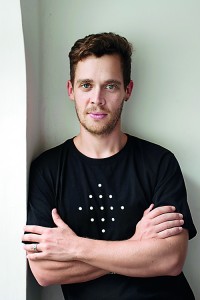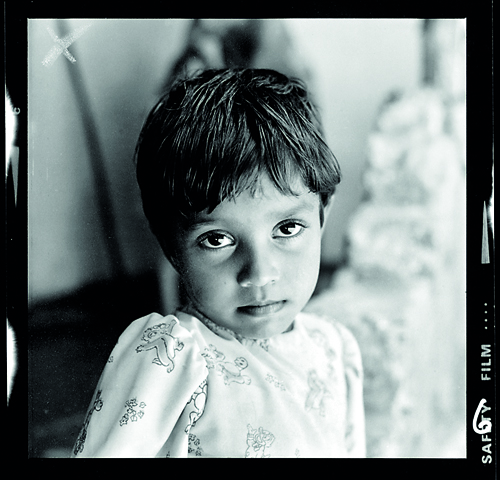Going back to known places and faces
Some of the most interesting moments in Aaron Burton’s film ‘My Mother’s Village,’ come when people sit watching themselves. There, captured on the screen, they are as they were over 30 years ago. The passing of time solidifies in that moment, etched in to the very lines of people’s faces. Chandrawathie’s face now, for instance, is fuller, her hair more grey than white. Priyanthi just a child then, has a child of her own. She fidgets and twists by her side, finding it hard to recognize her grandmother in the flickering images on their T.V. While everyone watches the films, Aaron watches them. Some he has known all his life, others only knew his parents; some are strangers, who only relax when they see the people they once knew talk so easily with Sharon Bell in the three movies she made.

Aaron Burton
As ‘My Mother’s Village’ begins, the narrator speaks: “Anthropologist mother. Cinematographer father. Mother’s voice, father’s gaze. Is that how it works?” Between 1976 and 1978, Sharon Bell and Geoff Burton lived and worked in Sri Lanka. Sharon chose Kanewala, a village some 35km from Colombo as her base, while she did the research for her PhD thesis. Titled ‘Women and Wage Labour: The Impact of Capitalism in Southwest Sri Lanka,’ she also made three films to accompany them, with Geoff serving as her cinematographer and co-director.
Known as ‘The Sri Lanka Series’ each was about a distinct community. In‘Dancers Were Only Allowed to Dance’ we encountered a caste of dancers and drummers in Pelpitigoda; ‘Fishermen of Duwa’ explored the challenges faced by this predominantly Catholic community, following them through the staging of their annual Passion Play and in ‘Four Women,’ Sharon introduced us to the women she considers her friends in Kanewala.
Made in the tradition of Cinémavérité, Aaron’s research revealed that the films were unique for that period in Sri Lanka, providing unusually intimate portraits of village life. “My mother was an outsider and an anthropologist, living for a long time in the village and she wasn’t in a hurry, so the responses from the women were very candid and honest. Sharon and Geoff gave them a stage to express their feelings about daily village life, which I think was quite rare in government documentaries of the day.”
When Aaron arrived in Sri Lanka – ready to work on his own PhD thesis – he didn’t have a plan. Instead, he wanted to start by screening the original films. These had been shown when they were first made, but that was over three decades ago. As Colombo audiences rediscovered them, so did the people in the villages where they were set. “I had this period in which to respond to my family’s ongoing relationship with Sri Lanka,” says Aaron.“I was very interested in inter-cultural cinema and wanted to pursue something along those lines, I was also highly influenced by my mother’s academic writings.”
After her return to Australia, Sharon had become critical of her own work in Sri Lanka, specifically of the choices she had made in whom to include and whom to leave out. People like Sunila Abeysekera who were both dear friends and indispensable guides to local life, had been left outside the academic frame. Now, Aaron decided he would find room for his own experiences in the new film, even as he revisited the same people to see what had become of them in the intervening years. In this intergenerational narrative, one of the stories told would be his own.
These little montages would also serve to knit the film together – essential since this is in fact three films in one (slightly longer than

A still from the film and below the filmmaker Aaron Burton
average) documentary. Returning to the village, Aaron found himself fascinated by how life had changed, the mud paths and thick forests giving way to development and paved roads. New generations had been born, and Aaron was interested in the dramatic changes in their lives – many spoke English, some had left the village and now held corporate jobs.
Some families fortunes had changed for the better but increased financial security had proven no buffer against loss and grief. Like Sharon before him, Aaron seems to have earned the trust of the people he interviewed. They speak to him candidly about everything from their sex lives to the effect the long conflict has had on their lives and the progress their communities have made. Where his parents noted that the beauty of the countryside masked issues of poverty, caste divides and harsh conditions, Aaron found cement had replaced wilderness but time had left some issues unaltered and birthed new ones. In fact, the Censor Board, citing the ‘extreme sensitivity’ of conversations around caste has only approved the film for academic screenings. (You can find a few scenes online at Aaron’s youtube channel.) Noting that village life seems ever more mythologised, Aaron found himself chronicling the ongoing ‘transformation of stories.’
Somewhat disappointingly, Aaron could not get the film a slot on the international circuit. Like the three films made before, it’s quiet and meditative and takes its own time. Aaron has since come to embrace this, recognizing that his primary audience isn’t an international one or even Australian, but Sri Lankan. Often he sees the movie inspire a piercing nostalgia for village life, confirming the notion of rural communities as a receptacle for the pure, the simple, the untouched. Like his parents before him, Aaron knows the truth is more complicated than that. He confronts it time and time again in this long, visual letter to them. It is a creation half his, half theirs, and in the final reckoning, belongs as much to the past as to the present.
S.D.
| As part of Colomboscope 2014, Aaron Burton’s documentary film ‘My Mother’s Village’ will be screened on January 31, between 3 – 4:30 p.m. at the New Town Hall. Entrance is free. |


